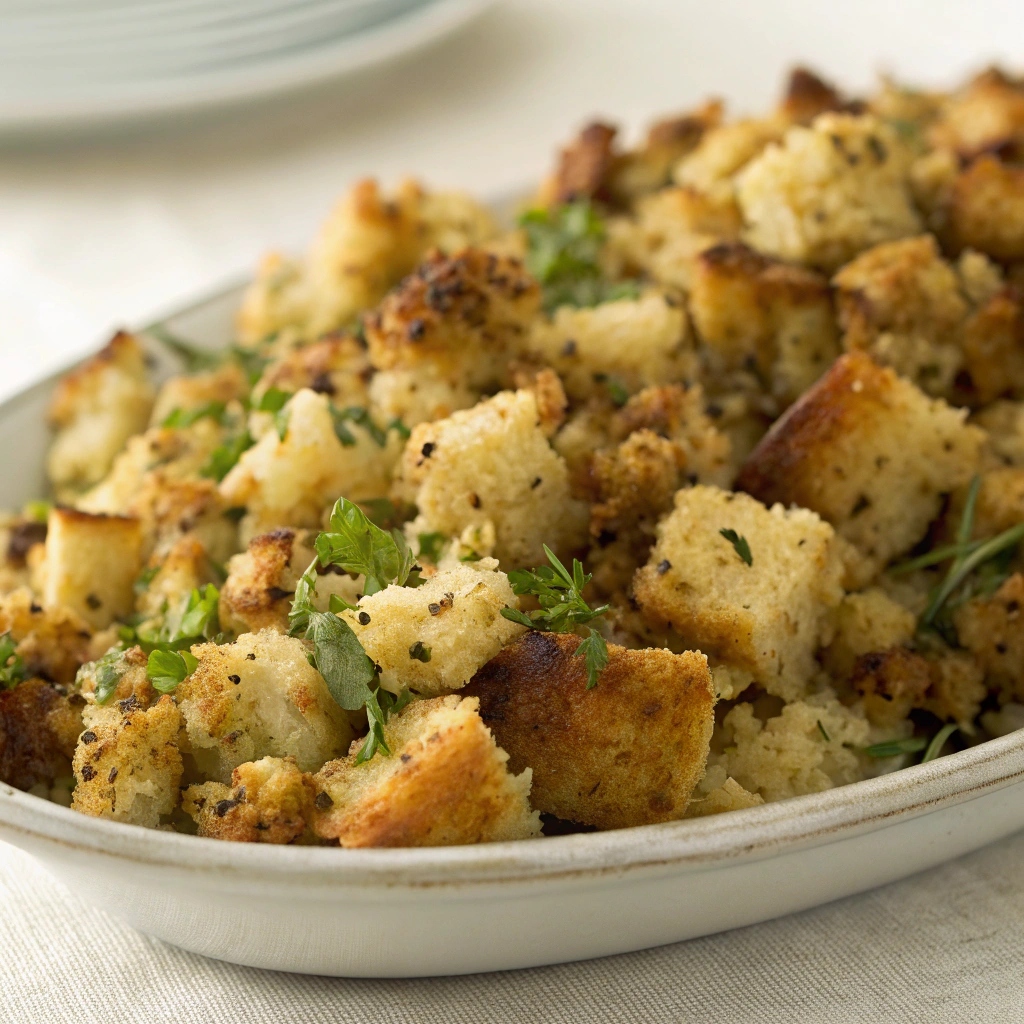When it comes to Thanksgiving, one dish that stands out as a quintessential companion to turkey is stuffing—or dressing, depending on how it’s prepared. This hearty side dish is beloved for its ability to soak up all the delicious flavors of the holiday feast, making it an essential component of any Thanksgiving table. In this article, we’ll explore the history of stuffing, discuss how to make the perfect version, and share tips for customizing this classic dish.
The origins of stuffing can be traced back to ancient times when people would fill the cavities of animals with various ingredients before cooking them. The word “stuffing” itself comes from the French term “farce,” which means to stuff or to fill. Over the centuries, stuffing has evolved into many forms and has varying names based on cultural preferences and preparation methods.
In the United States, stuffing became popular with the introduction of various recipes that adapted to regional tastes. While “stuffing” typically refers to the mixture cooked inside the turkey, “dressing” is a term used for stuffing that is prepared in a separate dish. No matter the name, one thing is clear: stuffing is a comfort food staple that adds depth and flavor to the holiday meal.
Essential Ingredients for Stuffing Recipe
The beauty of stuffing lies in its versatility. While the base is typically made from cubed bread, there are many variations that can enhance the flavor profile. Here are the essential ingredients you’ll need to create a classic stuffing:
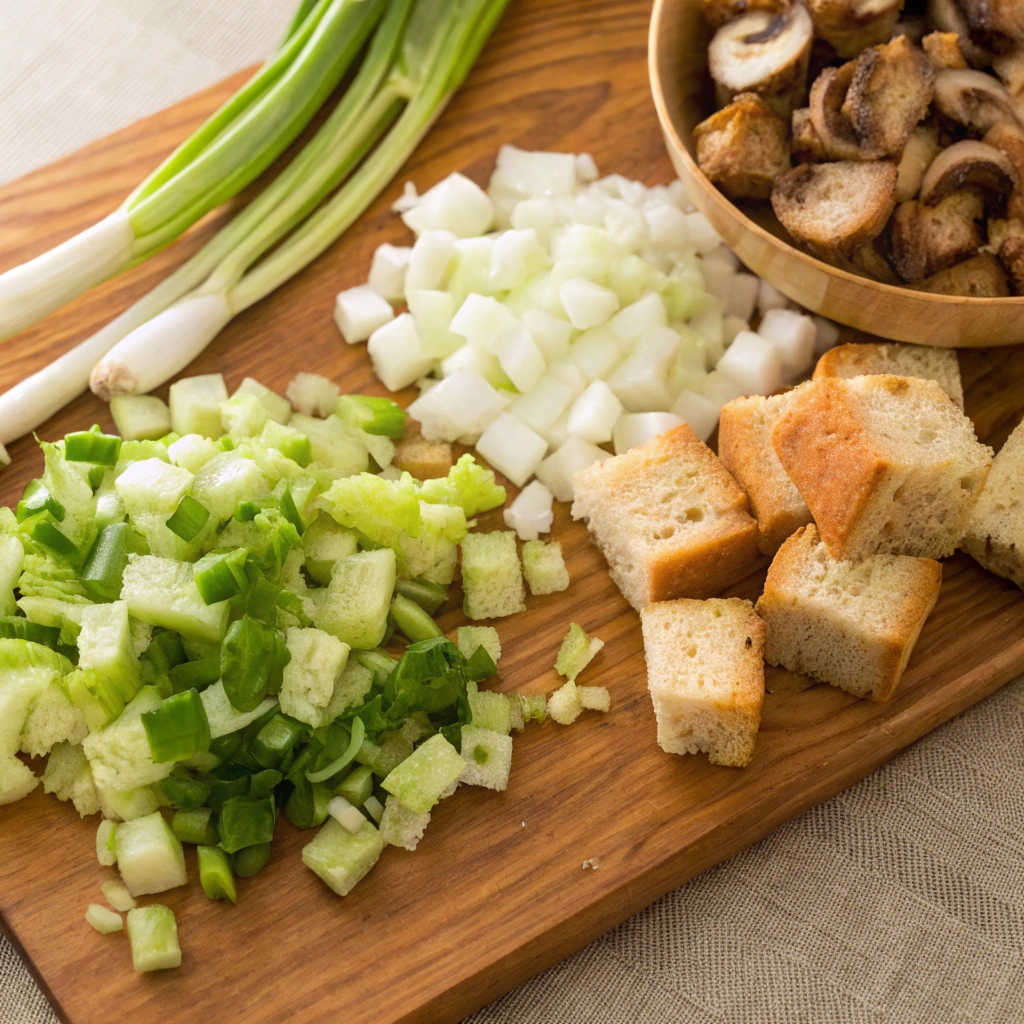
- Bread:
About 4-5 cups of cubed bread (day-old baguette, French bread, or a sturdy white or whole wheat bread). Dry bread absorbs flavors and creates a fluffy texture. - Vegetables:
- 1 cup chopped onion
- 1 cup chopped celery
- Optional: diced carrots or mushrooms for added flavor and texture
- Herbs and Spices:
- 2-3 cloves garlic, minced
- 1-2 teaspoons dried sage
- 1 teaspoon dried thyme
- 1 teaspoon dried rosemary
- Salt and freshly ground black pepper, to taste
- Broth:
1 to 1½ cups chicken broth or vegetable broth (for vegetarian version), heated for moistening the bread - Fat:
2-4 tablespoons butter (or olive oil for vegan), used to sauté vegetables and add richness - Add-ins (Optional):
- Cooked sausage, bacon bits, or diced cooked turkey for extra flavor
- Diced apples or cranberries for a sweet contrast
- Nuts (like pecans or walnuts) for crunch
How to Make the Perfect Stuffing Recipe
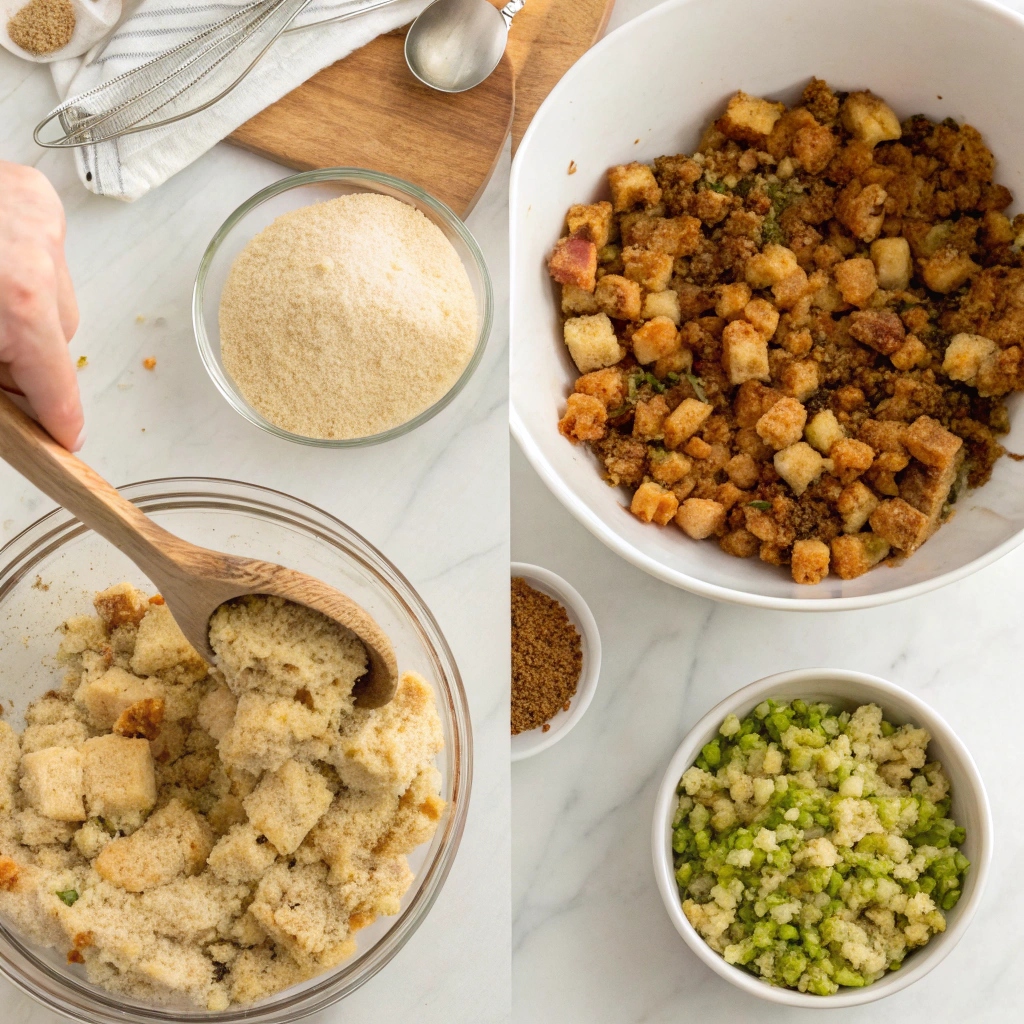
1. Choose the Right Bread
- Use sturdy bread such as French baguette, Italian bread, sourdough, or rye. Day-old or toasted bread works best because it absorbs flavors without becoming soggy.
- Cut the bread into 1 to 1½-inch cubes. Spread slices on a baking sheet and toast at 350°F (175°C) for 10–15 minutes until lightly crisp. Let cool.
2. Prepare the Aromatics and Vegetables
- Finely chop onions, celery, and optional carrots or mushrooms.
- Mince garlic for added flavor.
3. Sauté the Vegetables
- In a large skillet, melt 2-4 tablespoons of butter or heat 2 tablespoons of olive oil over medium heat.
- Add the onions, celery, and other vegetables.
- Sauté until tender and fragrant, about 5–7 minutes.
- Stir in the garlic and cook for an additional minute.
4. Add Herbs and Seasonings
- Incorporate dried herbs (sage, thyme, rosemary) and season with salt and freshly ground pepper.
- Stir well to release aromatic flavors.
5. Combine Bread and Sauteed Aromatics
- In a large mixing bowl, toss the toasted bread cubes with the sautéed vegetables and herbs.
- Mix gently to ensure even distribution.
6. Moisten the Mixture
- Gradually pour 1 to 1½ cups of hot chicken or vegetable broth over the bread mixture.
- Gently fold to evenly coat all the bread.
- The mixture should be moist but not soggy—add more broth if needed.
7. Optional Add-ins
- Mix in cooked sausage, bacon bits, diced turkey, or dried cranberries for extra flavor.
- Add chopped nuts or diced apples for texture and a touch of sweetness.
8. Bake the Stuffing
- Transfer the mixture to a greased baking dish.
- Cover with foil and bake at 350°F (175°C) for 30 minutes.
- Remove the foil and bake for an additional 10–15 minutes to crisp the top and develop a golden crust.
9. Serve
- Let the stuffing rest for 5 minutes before serving.
- Garnish with fresh herbs such as parsley or sage for a finishing touch.
Tips for Success When Making Delicious Stuffing
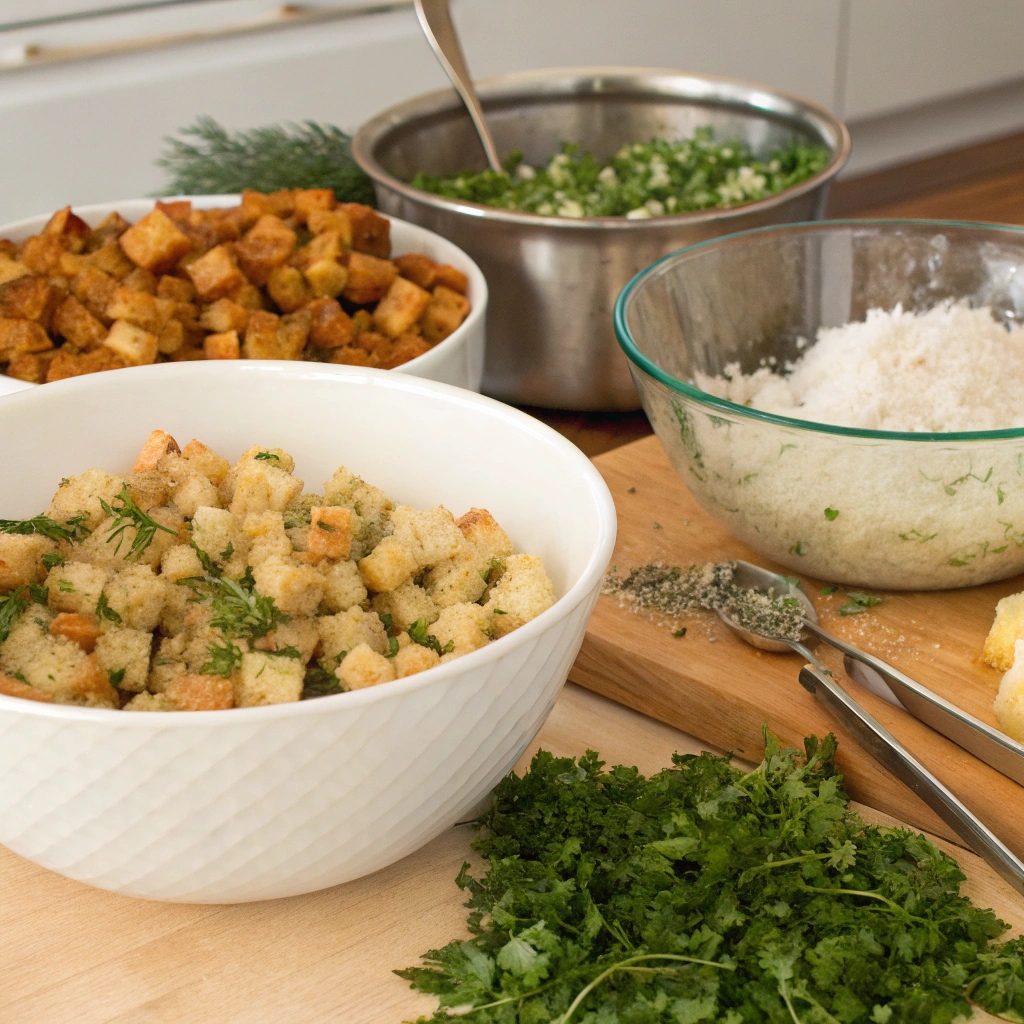
1. Use the Right Bread
- Choose Sturdy, Day-Old Bread: Use bread with good structure like French baguette, sourdough, or Italian loaf. Slightly stale or toasted bread absorbs liquids better and prevents sogginess.
- Toast the Bread: If using fresh bread, toast the cubes in the oven at 350°F (175°C) for 10-15 minutes until lightly crisp. This extra step enhances absorption and adds a nice texture.
2. Properly Sauté Vegetables and Aromatics
- Cook Vegetables Thoroughly: Sauté onions, celery, and any other veggies until tender and fragrant—this develops their sweetness and flavor.
- Don’t Rush: Taking time to cook the vegetables releases their natural sugars, adding depth to your stuffing.
3. Balance Moisture
- Control Liquids: Pour broth gradually and mix gently; the mixture should be moist but not soggy.
- Adjust as Needed: If the stuffing seems dry after mixing, add a little more warm broth. If too wet, add more toasted bread cubes.
4. Use Fresh and Aromatic Herbs
- Enhance Flavor: Incorporate fresh herbs like sage, thyme, or parsley. Add them at the right time—herbs stirred into the sautéed vegetables release more aroma.
- Don’t Overdo It: Balance is key; too many herbs can overpower the dish.
5. Avoid Overmixing
- Keep It Light: Gently fold all ingredients together. Overmixing can result in a dense, gummy texture instead of fluffy, moist stuffing.
6. Proper Packing and Baking
- Don’t Pack Tightly: Transfer the mixture into your baking dish loosely. Light packing allows steam to escape, resulting in a fluffy texture.
- Cover and Uncover: Cover with foil during the initial baking to keep moisture in, then uncover for the last 10-15 minutes to crisp the top.
7. Temperature and Timing
- Bake at the Right Temperature: 350°F (175°C) ensures even cooking.
- Don’t Under or Overbake: Check for doneness by inserting a toothpick in the center — it should come out clean, and the top should be golden brown.
8. Make Ahead for Convenience
- Assemble the stuffing a day in advance, cover tightly, and refrigerate. Bake just before serving for a warm, freshly baked texture.
- Let the assembled dish sit at room temperature for 20–30 minutes before baking to ensure even heating.
9. Variations and Personal Touches
- Customize Fillings: Add cooked sausage, cranberries, nuts, or cheese for added layers of flavor.
- Add a Crunch: Top with extra toasted bread crumbs or chopped nuts towards the end of baking.
Customizing Your Stuffing Recipe
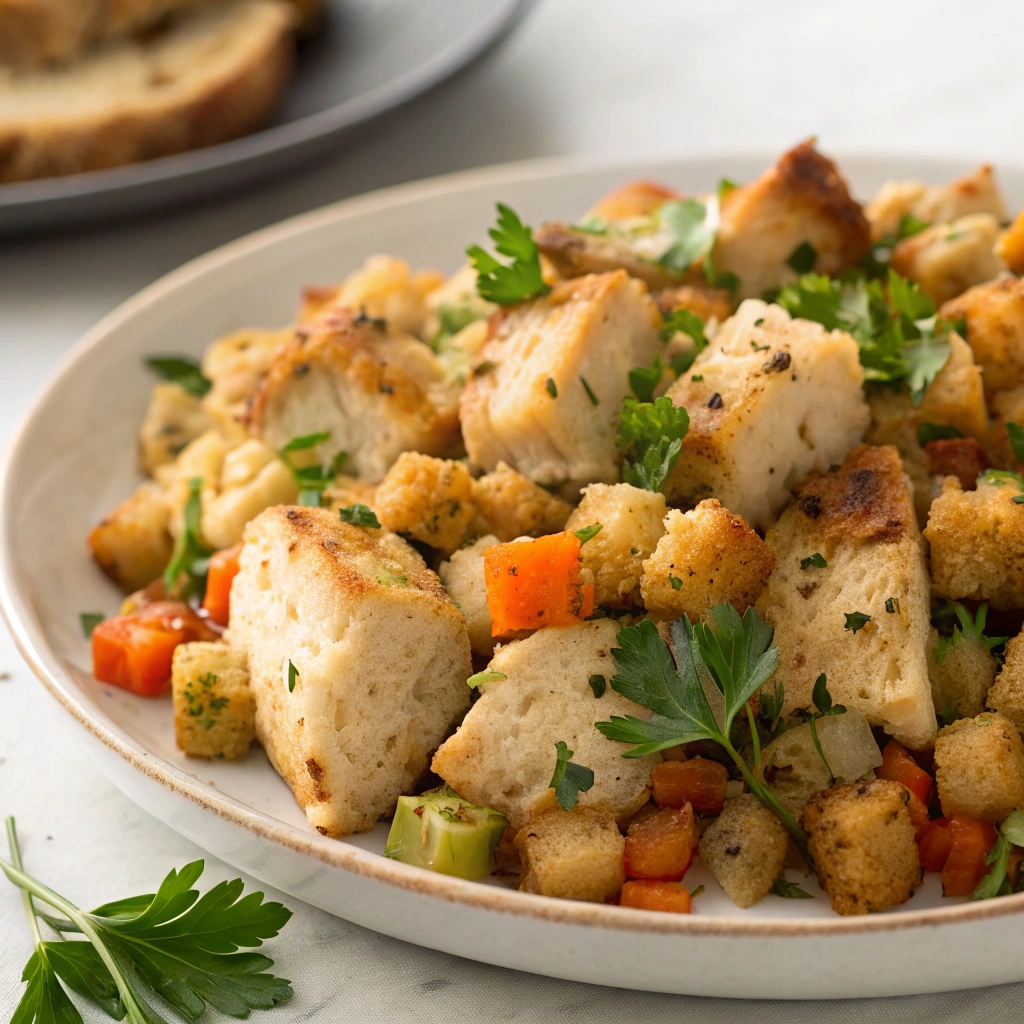
Personalize your stuffing to suit your taste, dietary needs, and occasion by exploring these options:
1. Vegetarian and Vegan Variations
- Skip the Meat: Omit sausage or bacon and add extra vegetables like mushrooms, roasted squash, or diced peppers.
- Add Plant-Based Proteins: Incorporate cooked lentils, cubed tofu, tempeh, or chickpeas for added texture and protein.
2. Gluten-Free Options
- Use Gluten-Free Bread: Replace regular bread with gluten-free options such as rice casserole or gluten-free bread cubes.
- Check Add-ins: Ensure all ingredients, including broth and seasonings, are certified gluten-free.
3. Flavor Profile Changes
- Herb Variations: Use fresh herbs like sage, rosemary, thyme, or parsley depending on your preferred herbal flavor.
- Spice It Up: Add cayenne pepper, crushed red pepper flakes, or diced jalapeños for some heat.
- Citrus Zest: Incorporate lemon or orange zest for brightness.
4. Adding Fruits and Nuts
- Sweet Touch: Mix in dried cranberries, chopped apples, or diced apricots for a sweet contrast.
- Texture and Crunch: Top with toasted walnuts, pecans, or sliced almonds before baking.
5. Cheese Choices
- Cheddar, Parmesan, or Swiss: Mix different cheeses into the stuffing for richer flavor.
- Vegan Cheeses: Use dairy-free cheese alternatives for plant-based versions.
6. Incorporating Different Proteins
- Cooked Sausages: Choose spicy or mild sausages such as turkey, chicken, or plant-based sausage.
- Seafood Additions: Incorporate cooked shrimp or crab for a seafood twist.
7. Serving Style Variations
- Stuffed Vegetables: Use hollowed-out squash, bell peppers, or mushrooms to stuff with your prepared mixture for an elegant presentation.
- Layered Casserole: Create layered versions with various fillings for visual appeal.
Tips for Successful Customization:
- Always ensure moisture levels are balanced—add broth gradually as needed.
- Keep flavors balanced—adding bold herbs and spices without overpowering other ingredients.
- Adjust cook time if adding extra moist ingredients like fruits or raw vegetables
Serving Your Stuffing Recipe
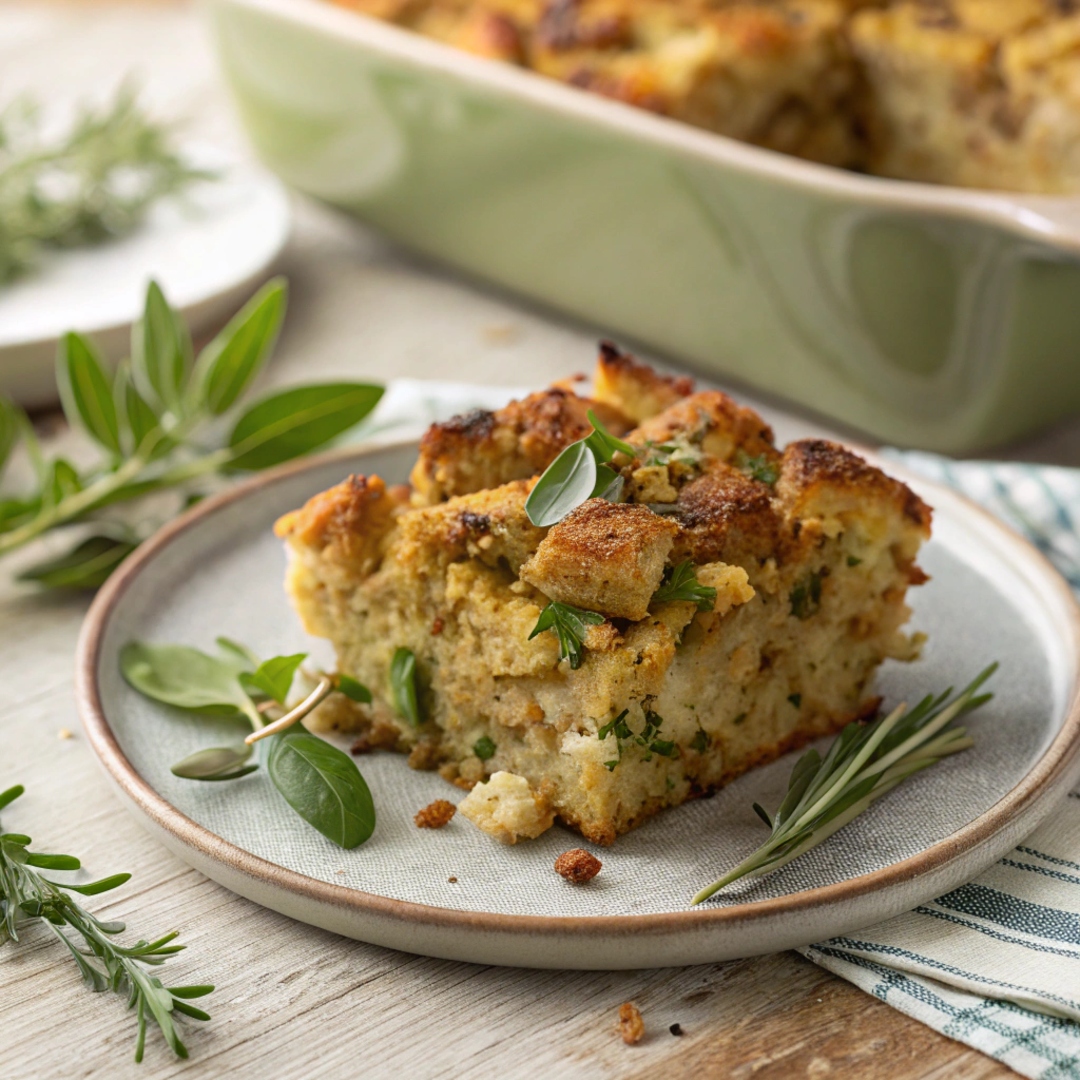
Presentation Tips For Stuffing Recipe
- Serve Warm:
Always serve stuffing hot and fresh for the best flavor and texture. Reheat leftovers thoroughly before serving. - Use Nice Dishes:
Present the stuffing in a rustic serving dish, a decorative casserole, or individual ramekins for a polished look. - Garnish Creatively:
Finish with a sprinkle of fresh herbs like parsley, sage, or thyme. Adding additional toppings such as crispy bacon bits, toasted nuts, or a drizzle of gravy can elevate the presentation. - Add Accent Sides:
Pair your stuffing with colorful sides like roasted vegetables, cranberry sauce, or fresh salad for a complete, vibrant plate.
Serving Ideas For Stuffing Recipe
- Family Style:
Scoop generous portions onto plates or serving trays, allowing everyone to help themselves. - Individual Servings:
Serve individual casseroles or ramekins as part of a plated meal, perfect for dinner parties or holiday gatherings. - Stuffing-Stuffed Vegetables:
Hollow out small squash, bell peppers, or mushrooms, fill with steaming hot stuffing, and bake for an elegant presentation. - Make It a Centerpiece:
Serve in the same dish it’s baked in, especially if baked in a cast-iron skillet or beautiful ceramic dish—great for casual family feasts.
Additional Tips:
- Serve with Sauces or Gravies:
A drizzle of gravy or a tangy cranberry sauce pairs wonderfully with the savory flavors. - Slice and Serve:
Allow to cool slightly, then cut into slices or squares for neat presentation at buffets or brunches. - Label Your Dish:
If serving a buffet, use a decorative tag or label to identify the dish, especially useful for dietary options (gluten-free, vegan, etc.).
Storing, Reheating, and Meal Prep Tips for Stuffing
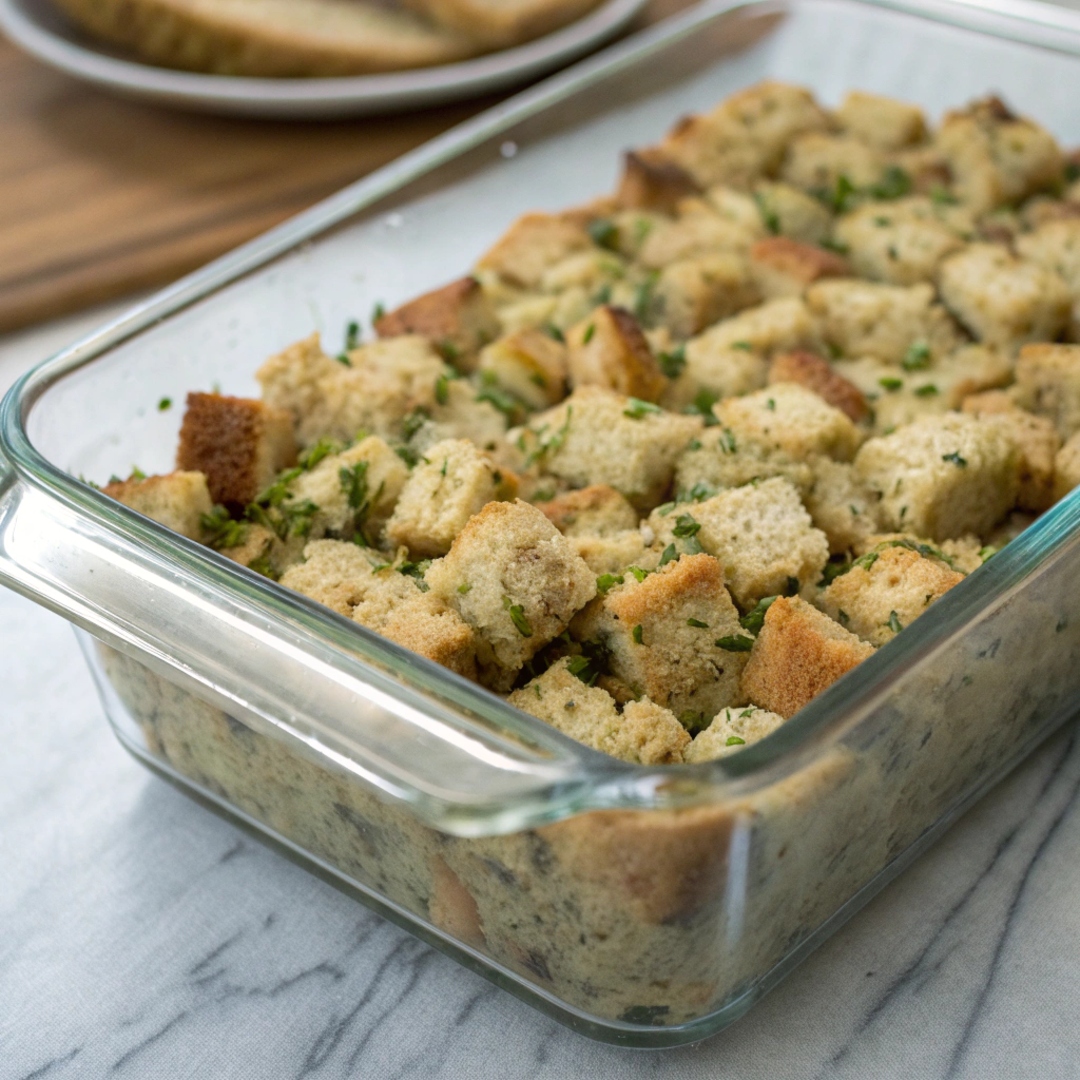
Storing Leftovers of Stuffing Recipe
- Cool Completely:
Allow the stuffing to cool to room temperature within two hours after baking to prevent condensation, which can cause sogginess or spoilage. - Airtight Containers:
Store leftovers in airtight containers or resealable plastic bags to maintain freshness and prevent odor transfer in the fridge. - Refrigerate:
Keep refrigerated for up to 3-4 days. For best quality, consume within this timeframe. - Freeze for Longer Storage:
For extended storage, portion leftovers into freezer-safe containers or freezer bags. Label with the date and freeze for up to 2-3 months. Wrap tightly to prevent freezer burn.
Reheating Leftovers of Stuffing Recipe
- Oven Method (Best for Even Heating):
- Preheat your oven to 350°F (175°C).
- Transfer the stuffing to a baking dish, cover with foil, and bake for 20-25 minutes until heated through and bubbling.
- Remove foil for the last 10 minutes to crisp the top if desired.
- Microwave Method (Quick & Easy):
- Place a portion in a microwave-safe dish and cover with a microwave lid or damp paper towel.
- Microwave in 1-minute intervals, stirring in between, until hot throughout.
- Heating time varies but typically takes 2-3 minutes depending on portion size.
- Stovetop Method:
- Add leftovers to a skillet or saucepan.
- Dot with a small amount of broth or water and heat over medium-low heat, stirring occasionally, until steaming hot.
Meal Prep Ideas For Stuffing Recipe
- Make Ahead:
Assemble the casserole the night before. Cover tightly and refrigerate overnight. Bake fresh in the morning for a warm, ready-to-serve meal. - Individual Portions:
Divide into smaller containers for quick grab-and-go meals throughout the week. Reheat as needed. - Freeze in Portions:
Portion leftovers into freezer-safe containers or bags. Thaw overnight in the fridge and reheat for quick, home-cooked meals. - Batch Cooking:
Prepare a large batch and store in the fridge or freezer. Perfect for busy weeks or holiday planning ahead.
Frequently Asked Questions About Stuffing Recipe
Q1: What makes a great stuffing recipe?
A great stuffing recipe features flavorful herbs, quality bread, moist ingredients, and tasty mix-ins like sausage, vegetables, or nuts. The perfect balance of crispy top and tender inside elevates your stuffing to a new level.
Q2: Can I prepare a stuffing recipe ahead of time?
Absolutely! You can assemble the stuffing recipe the night before, cover tightly, and refrigerate. When ready, bake it and add a splash of broth if needed. It’s a big time-saver for holidays and busy mornings.
Q3: Is this stuffing recipe suitable for dietary restrictions?
Yes! Modify the stuffing recipe by skipping meat for vegetarian or vegan versions, use gluten-free bread for gluten sensitivities, and choose dairy-free options for allergies.
Q4: How much stuffing should I make per person?
Estimate about ½ to 1 cup of stuffing per person, depending on whether it’s a side dish or part of a larger meal. Prepare extra for big appetites or holiday gatherings.
Q5: How do I prevent my stuffing recipe from being soggy or dry?
Add broth gradually to moisten the bread until just damp—avoid soaking. Cover the casserole during baking to trap moisture and remove the foil at the end to crisp the top.
Q6: Can I add proteins or extras to my stuffing recipe?
Yes! Incorporate cooked sausage, bacon, shredded turkey, or sautéed vegetables for added flavor. Dried fruits or nuts also make great sweet and crunchy additions.
Q7: What are the best side dishes to serve with a stuffing recipe?
Pair your stuffing with roasted vegetables, cranberry sauce, green beans, glazed carrots, or your favorite main course like turkey, ham, or roast beef.
Q8: How should I store leftovers from my stuffing recipe?
Cool it completely, then store in airtight containers in the fridge for up to 4 days. For longer storage, freeze in portions for up to 3 months. Reheat thoroughly before serving.
Q9: Can I freeze a stuffing recipe?
Yes! Wrap it tightly or use freezer-safe containers, then freeze for up to 3 months. Thaw overnight in the fridge and reheat in the oven or microwave.
Q10: What tips help ensure my stuffing recipe has the perfect texture?
Use stale or day-old bread for better absorption, don’t overmix for a fluffy consistency, and bake until golden and crispy on top. Let it rest a few minutes post-baking for easy serving.
Conclusion about Stuffing Recipe
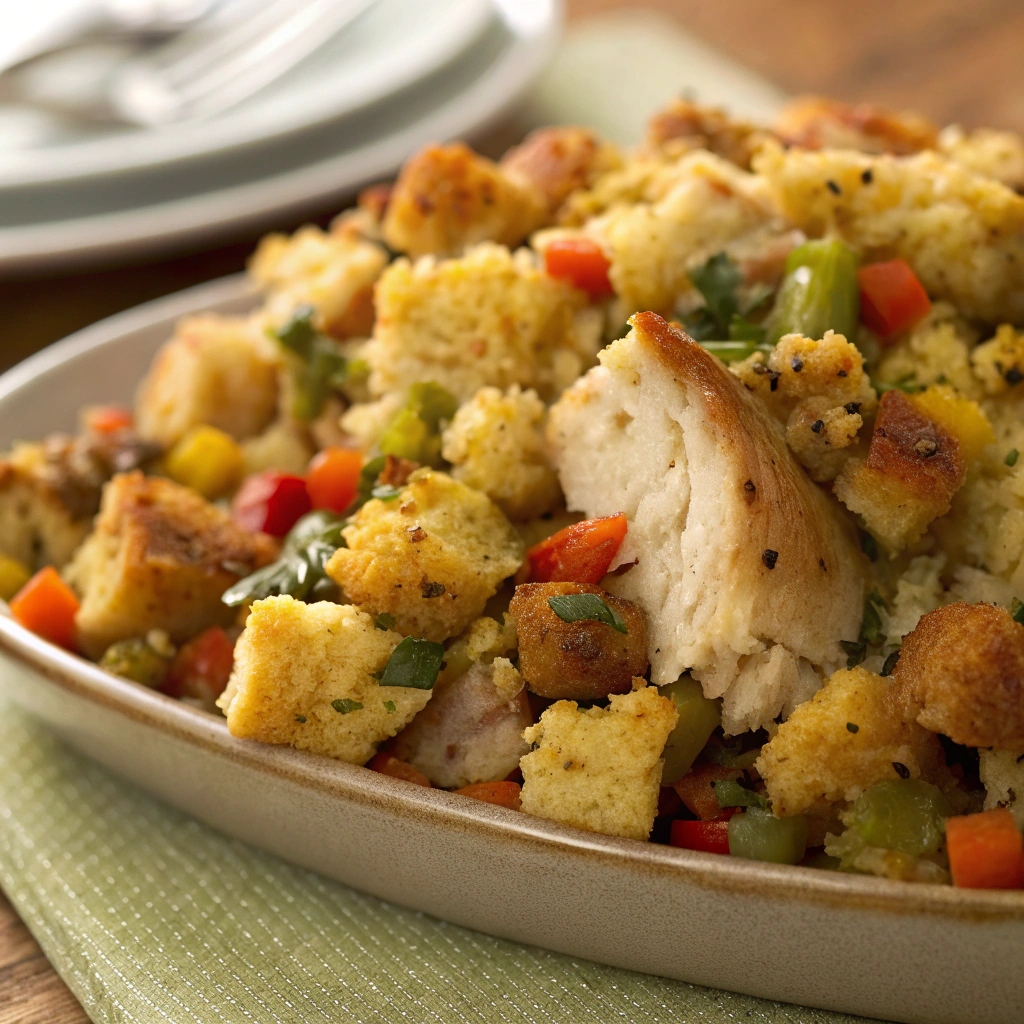
Stuffing recipe is more than just a side dish; it’s a beloved tradition that brings comfort and flavor to the Thanksgiving table. Whether you choose a classic version or one with unique twists, stuffing has the ability to absorb the flavors of the meal and pair beautifully with turkey and other dishes.
As you prepare for this year’s Thanksgiving feast, consider making stuffing from scratch using the tips and recipes provided in this guide. Your guests will undoubtedly appreciate the effort and warmth that comes with homemade stuffing, making your Thanksgiving celebration all the more memorable. Happy cooking and enjoy your holiday feast!
Explore More Recipes like Stuffing Recipe
If you enjoyed this article and are looking for more delicious recipes to accompany your Thanksgiving feast, check out these internal links to enhance your holiday menu:
These links will provide further inspiration for creating a memorable holiday meal!
For more delicious recipes and baking inspiration, come join us on Facebook at RyanRecipes. Follow us to stay updated with our latest creations and share your culinary adventures with our vibrant community!
